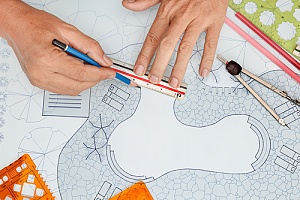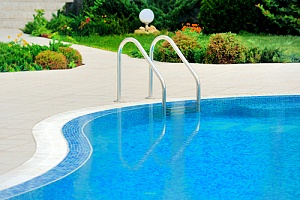 Putting in an inground swimming pool in your backyard is a wonderful way to get your whole family together to splash around and swim together. However, if you are thinking about putting in a pool, you should know how to estimate inground swimming pool costs in 2020.
Putting in an inground swimming pool in your backyard is a wonderful way to get your whole family together to splash around and swim together. However, if you are thinking about putting in a pool, you should know how to estimate inground swimming pool costs in 2020.
It is important to know what you are getting yourself into before you start the process. Taking a look into the average costs of getting a swimming pool put in can help you budget and save for the project, and allow you to find ways to either lower the cost or budget for the exact pool you want.
The Average Costs
When putting in a new pool, there are materials, labor costs, and a myriad of other expenses that make up the final amount. However, on average, the cost comes out to about $35,000. This number is the average amount that a homeowner spends on placing an inground swimming pool in their yard, but that number can vary slightly.
The total inground swimming pool costs can be higher or lower depending on the size and materials used, but the average pool size is 10 feet by 20 feet. This allows the pool to be twice as long as it is wide and makes the pool cost between 50-65 dollars per square feet.
What Affects the Cost?
When considering what the total cost of the job will be, there are many factors that play a role. Depending on the size and shape of the pool you want, you may need to pay a higher price for labor if you want something more unique or intricate. On the other hand, you may end up paying much less for a simple design.
The same can be said for the materials used and the number of design elements added to the basic structure. So, what are all of the factors that you should consider when putting in a new pool?
Pool Design
 As mentioned, the shape and size of the pool will be a major factor in the cost of the installation. If you would like to keep the costs a bit below the average, then going for a simple shape and smaller size will give you a lower total cost.
As mentioned, the shape and size of the pool will be a major factor in the cost of the installation. If you would like to keep the costs a bit below the average, then going for a simple shape and smaller size will give you a lower total cost.
However, if you choose to go with a specially-designed shape with lots of steps into the pool and areas to sit on, the price will likely be higher than the average cost. Deciding on what you can get for the price you want will be a major part of choosing a pool design.
Materials Used
Choosing the material that you want for your inground pool will also be a factor that can greatly affect the total cost of the project. With three major options to choose from, the price of the job can vary significantly depending on the material. In addition, each option has different levels of upkeep, which is another thing to consider.
Vinyl
Vinyl, although it can be cheaper, is a material that tends to need more maintenance, and the upkeep could end up costing more over time. The liner of the pool will have to be replaced every ten years, which could also add up over time if you need to replace it more than once.
In addition, vinyl does not necessarily cut costs for a smaller pool. For smaller-sized pools, the price doesn’t vary much from other materials, but for larger sizes, vinyl can be lower cost than the other materials for the same size pool. So, this may be a good option for those who would like a larger pool that won’t cost as much as the other choices.
Fiberglass
Using this material for your pool can keep costs low for smaller sizes. In addition, fiberglass is a very low maintenance material that does not need much upkeep and can last over 25 years without problems.
However, fiberglass is not the cheapest of materials to install. With a small pool, this will not be much of an issue, but with large sizes, you could end up paying nearly the same cost as concrete. Although they might end up being similar in price, concrete will last twice as long.
Concrete
 As the highest-priced option, but the one that lasts the longest, concrete is an option that many people prefer. However, paying the higher price for concrete may cause you to have to put in a smaller size pool than you would have liked. However, if you would like to save on the cost of installation, concrete can be a good choice.
As the highest-priced option, but the one that lasts the longest, concrete is an option that many people prefer. However, paying the higher price for concrete may cause you to have to put in a smaller size pool than you would have liked. However, if you would like to save on the cost of installation, concrete can be a good choice.
Concrete takes a lot to install, so even for smaller sizes, there will be a high price. However, a large pool does not take much more labor to fill, and you will mostly be paying for the material itself. So, getting a larger size will not increase the labor as much as it might with other materials.
Type of Water
This may not be something that you think about, but deciding whether you will have freshwater or saltwater in your pool can also affect the price. Saltwater requires no use of chemicals for cleaning but needs a generator that can add another $1,000 or more to the total cost.
Freshwater can be easier to fill the pool with, but it requires upkeep during the year with chemicals like chlorine for cleaning the water. These chemicals can be harsh on your clothes and skin, but does not require a generator.
Customizations
There are no limits to ways that homeowners can customize their pools, but customization comes at a higher cost. If you choose to add a hot tub or fountain to the pool, then you can expect to add another 2-to-10,000 onto your inground swimming pool costs.
Contact Dirt Connections For Help
Putting in a new pool is a big job, and deciding what materials to use and how big the pool should be for your yard can be tough. If you need help deciding, or just figuring out what your options are, you can contact Dirt Connections to speak with a professional about how to stay within your budget and get a quote for the work you need done!












































